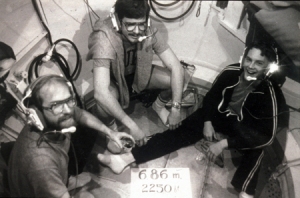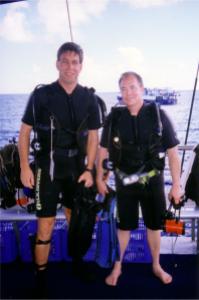This week, as the Space Shuttle is making its last circuits around our planet, I lament what has happened to our space program. Yet, I am reminded of another exploration program that has, like the shuttle and the moon programs, reached incredible milestones only to retreat to a less exotic but still impressive status. That other program is experimental, deep saturation diving.
I have been privileged to conduct human physiological research on several deep saturation dives, one being a record-breaking U.S. Navy dive at the Navy Experimental Diving Unit (NEDU) in 1977 to a pressure equivalent to that found at 1500 feet sea water (fsw), or 460 msw*, and on a 450 msw (1470 fsw) dive at the GUSI diving facility at the GKSS Institute in Geesthacht, Germany in 1990. For perspective, the safe SCUBA diving depth is considered to be 130 fsw, although technical and cave divers often descend deeper, to 300 fsw or so.

Dives in hyperbaric chambers like at GUSI and NEDU are simulated; the divers don’t actually go anywhere. But the effects of the high pressure on the divers’ bodies are just as they would be in the ocean. Of course, even in simulated dives, divers wear Underwater Breathing Apparatus, and descend into water contained within the hyperbaric complex.
In 1979, NEDU again set the U.S. Navy record for deep diving to 1800 fsw (551 msw). At Duke University in 1981, the U.S. record for pressure exposure was set by three saturation divers inside an eight-foot diameter sphere. The internal pressure was 2250 fsw (686 msw). One of those divers went on to become the senior medical officer at NEDU, none the worse for his high pressure exposure.
 The French company Comex, of Marseille used an experimental gas mixture of hydrogen-helium-oxygen to reach 675 msw, before being forced back to 650 msw due to physical and physiological problems with the divers. However, like teams attempting the summit of Mount Everest, one diver from the dive team was pressed to a world record of 701 msw (2290 fsw), just squeaking past the U.S. record.
The French company Comex, of Marseille used an experimental gas mixture of hydrogen-helium-oxygen to reach 675 msw, before being forced back to 650 msw due to physical and physiological problems with the divers. However, like teams attempting the summit of Mount Everest, one diver from the dive team was pressed to a world record of 701 msw (2290 fsw), just squeaking past the U.S. record.
There is a poorly understood physiological barrier called the High Pressure Nervous Syndrome (HPNS) that limits our penetration to ever deeper depths. In spite of the use of increasingly exotic gas mixtures, helium-oxygen in the U.S. Navy, helium-nitrogen-oxygen at Duke University, and hydrogen-helium-oxygen at Comex, all attempts to dive deeper have, to date, been rebuffed.
Just as I had thought as a young man that trips to the moon would be common-place by now, I had also assumed diving to 3000 feet would be routine. But it is not.
In my early research days I was interested in the effects on organisms of very high pressure, 5000 psi, which is equivalent to a depth of over 11,000 feet (3430 meters). We now know those effects can be profound, altering the very structure of cell membranes. Reversing those effects while maintaining high pressure, at great depth, is a daunting scientific task. We don’t yet know how to do it.
What we do know is that reaching 1500 feet can be done without too much difficulty. In the 1980s it became almost routine to dive to 1000 feet at both the Naval Medical Research Institute (Bethesda) and NEDU. Deep saturation diving is a thriving business in the oil fields of the Gulf of Mexico and the North Sea.

But as for the similarity between deep saturation diving and NASA’s moon missions, in the Apollo program it took slightly over three days to get to the moon, and almost an equal time to return. But as the above dive profile shows, it took sixteen days to reach the maximum depth of 1500 fsw, and seventeen days to safely return. Over that period of time astronauts would have whizzed past the moon and been well on their way to Mars. Unlike spacecraft and astronauts, divers must slow their descent to avoid HPNS, and must slow their return to the surface to avoid debilitating and painful decompression sickness. Diving without submarines or armored suits is very much a demanding, physical stress.
Politically, exceeding our current depth limits of approximately 2000 feet is akin to returning to the moon, and going beyond. We could do it, but at what cost? Should we? Will it ever be a national priority?
Maybe not for the United States, but I have a suspicion that other countries, perhaps not as heavily committed to space as we, will find the allure of beating current diving records irresistible. If there are medical or pharmacological interventions developed for getting divers safely and productively down to 3000 feet, then that would be a scientific achievement comparable to sending men to Mars.
*[The feet to meters conversion is slightly different from the feet of sea water to meters of sea water conversion. The latter represents pressure, not depth, and therefore includes a correction factor for the density of sea water.]








